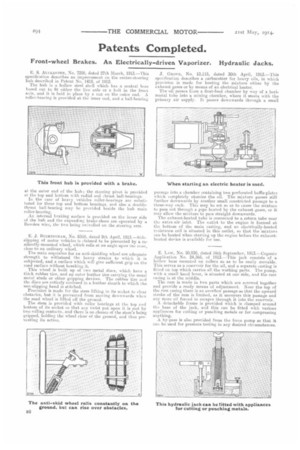Patents Completed.
Page 26

If you've noticed an error in this article please click here to report it so we can fix it.
Front-wheel Brakes. An Electrically-driven Vaporizer. Hydraulic Jacks.
E. S. ALCXANIIER, No. 7256, dated 27th March, 1913.—This specification describes an improvement on the centre-steering hub described in Patent No. 1418, of 1912.
The hub is a hollow steel shell which has a central boss bored out to fit either the live axle or a bolt in the front axle, and it is held in place by a nut on the outer end. A roller-bearing is provided at the inner end, and a ball-bearing at, the outer end of the hub; the steering pivot is provided at. the top and bottom with radial and thrust ball-bearings. In the case of heavy vehicles roller-bearings are substituted for these top and bottom bearings, and also a doublethrust ball-hearing may be provided beside the hub main roller-bearing.
An internal braking surface is provided on the inner side of the hub and the expanding brake-shoes are operated by a Bowden wire, the two being swivelled on the steering arm.
E. J. BUCHINCliAll, No. 8380, dated 9th April, 1913.—Sideslipping of motor vehicles is claimed to be prevented by a resiliently-mounted wheel, which rolls at an angle upon the road, close to an ordinary wheel.
The main requisites fur an anti-skidding wheel are adequate strength to withstand the heavy strains to which it is subjected, and a surface which will give sufficient grip on the road surface without breaking it. This wheel is built up of two metal discs, which have a thick rubber tire, and an outer leather tire carrying the usual metal studs or other gripping devices. The rubber tire and the discs are entirely enclosed in a leather sheath to which the non-slipping band is stitched. Provision is made for the stem lifting in its socket to clear obstacles, but it is prevented from moving downwards when the road wheel is lifted off the ground. The stem is provided with roller bearings at the top and bottom of its socket so that any twist put upon it is met by two rolling contacts, and there is no chance of the stem's being gripped, holding the wheel clear of the ground, and thus preventing its action. J. GnovE, No. 10,115, dated 30th April, 1913.—This specification describes a, carburetter for heavy oils, in which provision is made for heating the mixture either by the exhaust gases or by means of an electrical heater. The oil passes from a float-feed chamber by way of a horizontal tube into a mixing chamber, where it meets with the primary air supply. It. passes downwards through a small passage into a chamber containing two perforated baffle-plates which completely atomize the oil. The mixture passes still farther downwards by another small constricted passage to a hree-way cock. This may be set so as to cause the mixture to pass out through a pipe heated by the exhaust gases, or it mav allow the mixture to pass straight downwards. exhaust-heated tube is connected to a return tube near the extra-air inlet. The outlet to the engine is formed at the bottom of the main casting, and an electrically-heated resistance coil is situated in this outlet, so that the mixturs east be heated when starting up the engine before the exhaust. heated device is available for use.
E. LAW, No. 20,930, dated 16th September, 1913.—Cognate Application No. 24,365, of 1913.—This jack consists of a hollow base mounted oit rollers so as to be easily movable. This serves as a reservoir for the oil, and a separate casting is fitted on top which carries all the working parts. The pump, with a small hand lever, is situated at one side, and the ram easing is at the middle. The. ram is made in two parts which are screwed together and provide a ready means of adjustment. Near the top of the ram casing there is an overflow passage so that the upward stroke of the ram is limited, as it uncoyers this passage and any more oil forced in escapes through it into the reservoir. A detachable frame is provided which is clamped around the base of the jack, and this can be fitted with various appliances fox cutting or punching metals or for compressing anything.
A by-puss is also provided from the force pump BO that it can be used for pressure testing in any desired circumstances.


























